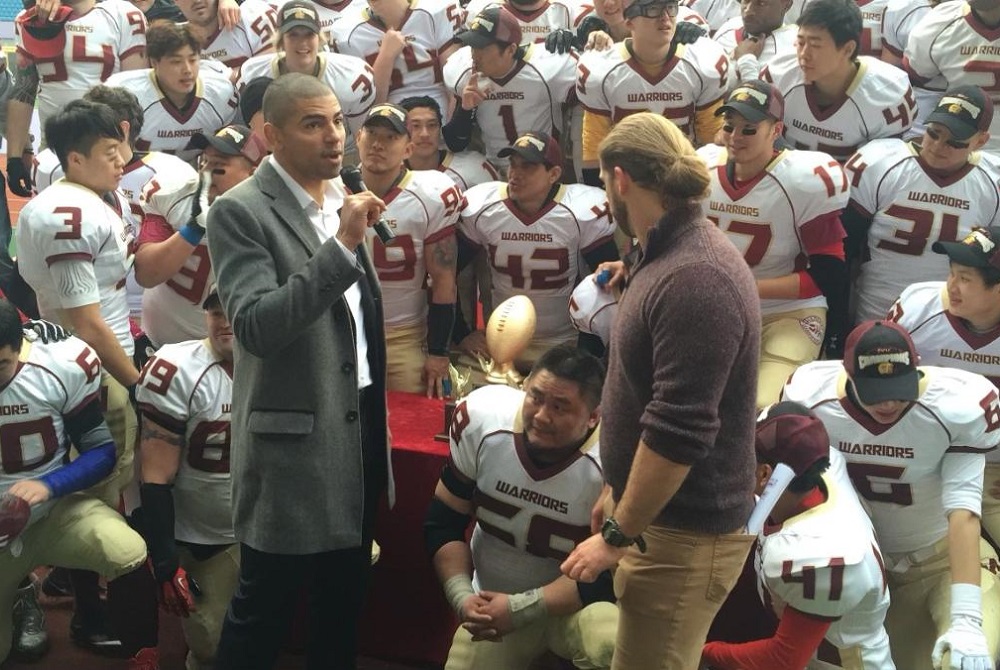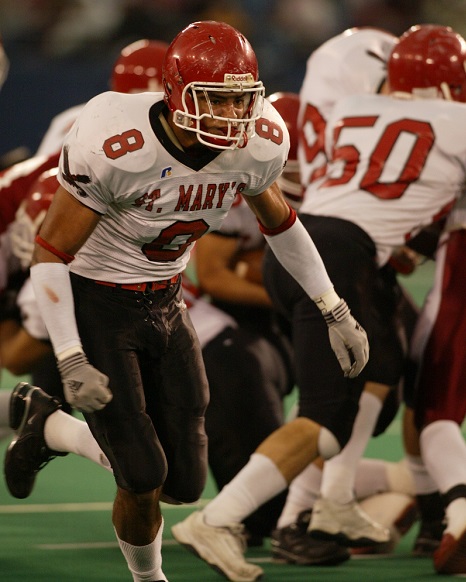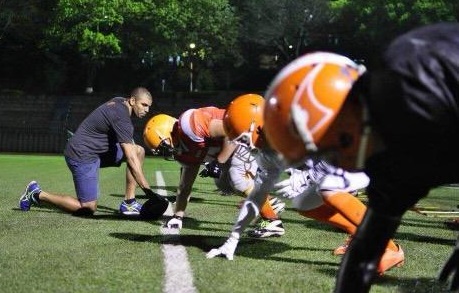
Trojans Find Familiar Success in 8-Player
October 5, 2016
By Dennis Grall
Special for Second Half
Football players, coaches and fans all know what it takes to produce winning teams: score a lot of points, don’t give up many, run, pass, catch and tackle.
 While 11-player football is the traditional way to play the game, declining school enrollments have forced numerous schools to adjust if they want to keep offering the sport. They are learning that 8-player football requires the same things to be successful.
While 11-player football is the traditional way to play the game, declining school enrollments have forced numerous schools to adjust if they want to keep offering the sport. They are learning that 8-player football requires the same things to be successful.
Crystal Falls Forest Park for decades dominated the ranks of Class D, which later became Division 8. The Trojans used a pretty simple game plan: find a stud running back, hitch their wagon to his burly shoulders and overpower any team which happened to be on the field.
Forest Park claimed the initial two Class D championships when the playoffs began in 1975 and added another title in 2007. The Trojans also won 23 Great Western Conference crowns.
But enrollment kept dropping, as it has throughout the state, and a year ago Forest Park officials decided to join the movement to 8-player football. There are 51 teams at that level this year, and nearby Felch North Dickinson, another long-time small-school power, will join the mix in 2017.
The decision was controversial when it was accepted by a 4-2 board of education vote last October, and many staunch Forest Park fans were aghast. But that apparently has cooled down, no doubt helped by a 5-1 start to this initial season.
“I don’t hear the griping of people against it,” said veteran coach and former Forest Park player Dave Graff. “The people in the know realize where our numbers are. That type of (negative) talk has gone by the wayside.
“We still have traditionalists out there who think 8-man is not football. This program is steeped in tradition, and you don’t get acceptance in one year’s time.”
The Trojans suit up 22 players for each varsity game, but nine are freshmen and sophomores who would be playing junior varsity football if Forest Park offered that level. “If we had jayvees we would not be able to function as a varsity unit,” Graff said.
The school enrollment is about 150 students this year, and Graff said he has been hearing it may drop by about 25-30 students next year. Forest Park has not fielded a full jayvee schedule for the past six years.
 Even more astounding is this observation from Bill Santilli, the school’s athletic director since Aug. 1 and a former all-state running back and long-time coach: “I really fear that in the next two years Forest Park will not have a football program.”
Even more astounding is this observation from Bill Santilli, the school’s athletic director since Aug. 1 and a former all-state running back and long-time coach: “I really fear that in the next two years Forest Park will not have a football program.”
Wow … this tradition-laden, statewide power on the threshold of no football?
Santilli added: “I’m fearful in the sense that four freshmen are playing, and we lose eight seniors. You do the math.”
He said Graff and Forest Park are being proactive and have worked with their Western Eight Conference to institute a junior high level of 8-player football and are also trying to get a grade 5-6 program started, possibly in flag football.
The school’s youth program has stayed with the 11-player game, and 2015 8-player MHSAA champion Powers North Central has kept an 11-player junior varsity. “It just doesn’t seem to be working because we’re all struggling with numbers there also,” said Santilli.
To give football a chance to hang around, he said, “We have to focus our attention on that youth level. We’re trying to build interest.”
While declining enrollment is forcing the switch to 8-player football, Santilli said, “Declining participation is probably more of a factor than it is enrollment. There are athletes in our school that in my opinion would make our football team better, but for some reason have not elected to play.”
Noting the game “nationwide is under attack,” he said it is safer now than ever because of increased improvement in equipment and extensive stress on safety. “Changes being made at every level are making the game as safe as it can be,” Santilli added.
Graff and Santilli, as players and coaches, have seen the values the sport provides.
“What are you trying to teach in football? We’re trying to teach work ethic, morals, not doing what is wrong when people aren’t watching, trying to teach character,” Graff said. “We are trying to raise people to be successful in our society and improve our society. We stress doing it right, we stress not missing the opportunity to do something good, the little things in life.
“Football is not just a rough sport. There are such great opportunities to teach things in life like discipline, teamwork, effort, enthusiasm, mental toughness, making good people.”
Santilli pointed out those lessons occur in both the 11-player game and the 8-player game. “It is still football. I’ve seen some great blocks and tackles and collisions out there,” said Santilli, who still resembles the powerful fullback who led the Trojans to their first Class D title in 1975 en route to a distinctive U.P. Sports Hall of Fame playing and coaching career.
 “I don’t see that any different with 8-man; there are just fewer players.”
“I don’t see that any different with 8-man; there are just fewer players.”
Santilli said some of his former teammates who now have youngsters playing have been hard to convince the switch to 8-player was necessary. “It is taking them a little bit longer to adapt to the change,” he said.
But, he said, “The players have slowly bought into the change. For them it is still the same game. There is the same excitement with the players, the same intensity when they take the field. They are just ready and waiting for the competition.”
Santilli, with his strong and successful background with the Trojans, might be the ideal observer of the switch, agreeing the game still requires athletes to make plays to stop other athletes.
“It is a different technique, a different style player more geared to open field situations (on both sides of the ball). Dave is still bringing Forest Park style football into his coaching, giving the ball to (Dan) Nocerini and powering it right at you.”
Nocerini is the latest standout back in a string of stars from Santilli and Graff who also included Mark Flood, Lee Graff, Dan Lato, Gerard Valesano and Dean Arcand. In just six games this season, the 6-foot-2, 217-pound senior has rushed for 1,186 yards and 20 touchdowns, highlighted by an opening-game 414 yards rushing and seven TDs.
“It is definitely a lot more open than I expected,” Nocerini said after that explosive opener at Rapid River. “Instead of beating a safety or a corner, you just have to beat one guy (downfield).”
He also said the players “have moved on. Everybody likes football; you just put your helmet on and go play.”
The acceptance of 8-player has been easier because the Trojans are as powerful as ever, losing only to North Central 60-42 in Week 2. They are averaging 56.3 points per game and allowing 28.3.
“People will see we have to go 8-man. There isn’t a choice,” Graff said. “We as coaches have come to grips with that ,and I think the community is coming to grips with it. The tradition is always there.”
 Denny Grall retired in 2012 after 39 years at the Escanaba Daily Press and four at the Green Bay Press-Gazette, plus 15 months for WLST radio in Escanaba; he served as the Daily Press sports editor from 1970-80 and again from 1984-2012. Grall was inducted into the Upper Peninsula Sports Hall of Fame in 2002 and serves as its executive secretary. E-mail him at [email protected] with story ideas for the Upper Peninsula.
Denny Grall retired in 2012 after 39 years at the Escanaba Daily Press and four at the Green Bay Press-Gazette, plus 15 months for WLST radio in Escanaba; he served as the Daily Press sports editor from 1970-80 and again from 1984-2012. Grall was inducted into the Upper Peninsula Sports Hall of Fame in 2002 and serves as its executive secretary. E-mail him at [email protected] with story ideas for the Upper Peninsula.
PHOTOS: (Top) Dan Nocerini of Crystal Falls Forest Park barges through a huge hole for a four-yard touchdown against Rapid River defenders David Johnson, left, and Gavin Harris (55) in their season opener. (Middle) Parker Sundell finds some running room after getting around Rockets defender Levi Miller. (Below) Roy Hagglund of Crystal Falls Forest Park reaches for a pass as Austin Wicklund of Rapid River defends. (Photos by Dennis Grall.)

St. Mary's Standout McLaurin Becomes Chinese Football Pioneer
By
Tom Markowski
Special for Second Half
August 19, 2021
The eight years Chris McLaurin spent in China not only changed his life, but they changed the perception of American football in China and elsewhere – and just may have opened the door to a whole new market.
 We're talking “American football,” not soccer. Most of us are familiar with NFL Europe, but NFL China? Not so much.
We're talking “American football,” not soccer. Most of us are familiar with NFL Europe, but NFL China? Not so much.
When McLaurin went to China in 2011, the thought of teaching the locals American football never occurred to him. He went there to work for a private company, and circumstances just seemed to fall in place.
Some might say McLaurin was in the right place at the right time, but it can also be said he was the right person at the right time to lead this undertaking. McLaurin had the background, both athletically and organizationally, to take on such an endeavor.
“I met a lot of people who were interested in football,” McLaurin said. “I thought, football? I had a limited understanding of what they knew. I was very surprised they would reach out to me. I quickly found out they were hungry to learn.”
A 2005 graduate of Orchard Lake St. Mary's, McLaurin started at tight end and linebacker, and helped the Eaglets reach the MHSAA Division 2 Final in 2004 (where they lost to Muskegon). McLaurin went on to play four seasons at Michigan and graduated in 2009 with a degree in history and minor in urban and community studies. He had thoughts of entering law school when other opportunities interceded.
During his time in Ann Arbor, McLaurin worked with an organization that focused on disadvantaged youth in the area and helped open doors for them. They were allowed to attend lectures at the university as well as sporting events.
Upon graduation, the seeds that would blossom in Asia began being sown in other parts of the world.
McLaurin received a Fulbright Scholarship and went to Johannesburg, South Africa, to work with underprivileged youth as part of a program called Tomorrow Trust. During this time he worked with the United Nations Development Programme and Harvard Law School in their pursuit of promoting economic rights for the poor.
Following his work in South Africa, McLaurin began his post-graduate work at the London School of Economics. He earned his degree after working in the House of Commons and as a research assistant for the Runnymede Trust. Then came a six-month internship within the Obama Administration as part of the White House Domestic Policy Council.
And after that, he was off to Chongqing in western China to work for a private equity company as a project manager. Two years later, he started his own company in addition to a non-profit organization. Much of his work centered on the automobile industry and global technology.
During this time he learned to speak Mandarin and, in doing so, was introduced to more of the local customs – including American football.
 What McLaurin found was a rudimental brand of football, what we would term a recreational type of competition. McLaurin began his involvement gradually, on weekends.
What McLaurin found was a rudimental brand of football, what we would term a recreational type of competition. McLaurin began his involvement gradually, on weekends.
“After that first year (2012), I took it up a notch,” McLaurin said. “We started recruiting players and bought new equipment. They watched football on TV, but it's not an easy game to understand. You have to play football to learn it. You don't get that from watching TV.”
A year of training, recruiting and, yes, some frustration, led McLaurin to start a league, the American Football League of China (now known as the China National Football League). The rules are similar to those at the U.S. college level. There are 11 players a side, and when a ball carrier's knee touches the ground the play is over.
In the beginning “it was successful,” he said. “There were no leagues when I got there. There was no one to organize it. We went from (fewer than) 10 teams to, 3-to-4 years later, there are 80-90.”
McLaurin quickly learned he needed help if this adventure was to succeed. USA Football had a footprint in Shanghai, and McLaurin reached out to the organization. McLaurin contacted a handful of former teammates including Prescott Burgess and Morgan Trent for advice. Former NFL player Bruce Plummer and NFL coach and scout Jerry Hardaway worked some of the camps and clinics with McLaurin and added much-needed experience and expertise.
After playing at Southern Illinois, Hardaway’s first coaching position was at Memphis State as an assistant, and then he went to Grambling State to coach under the legendary Eddie Robison for six seasons. He also coached at the University of California under Joe Kapp prior to working in the NFL and then heading to China.
“I was told, through another guy, that (McLaurin) needed some help,” Hardaway said. “It was all about getting back to basics. That's what made it fun. They had no clue when you'd say to them, control the ground at impact when you're making a block. They had no idea of the terms that you'd use. To see the young kids, to see on their faces, they were absorbing everything.
 “Yes, yes, yes, it was worthwhile. First of all, people had no clue about what it takes to do something like this. They were learning. Some of the parents thought it was a violent sport. That's what they heard. Then they switched. They saw me, us, teach the basics and they saw what we were doing. For me, it gave me a sense, like hey, you have to teach and you have to enjoy it.”
“Yes, yes, yes, it was worthwhile. First of all, people had no clue about what it takes to do something like this. They were learning. Some of the parents thought it was a violent sport. That's what they heard. Then they switched. They saw me, us, teach the basics and they saw what we were doing. For me, it gave me a sense, like hey, you have to teach and you have to enjoy it.”
Soon after that first season, the NFL got involved as did the National Committee on United States - China Relations. McLaurin credits the NFL for advising him on the business end of starting a new league and structuring. After 18 months, McLaurin got out of coaching and became the commissioner.
“(The NFL) wanted to expand,” he said. “They saw how their brand was quite low (in China). China is a natural.”
Progress was slow, but it was still progress. The 2015 championship game was played in Shanghai, and McLaurin estimates it drew 3,500 spectators.
He continued to work with the AFLC through 2019 but then decided to make a career move. He returned to the U.S. and, this fall, is pursuing a dream he's held since leaving U-M. At age 34, McLaurin entered Harvard Law School.
“When I started, the last thing we wanted was a U.S. version of football,” he said. “We wanted it to be Chinese football. There were limitations on how many foreigners would compete. At first it was five (per team), then three. We wanted it to be a Chinese experience."
2020-21 Made in Michigan
August 5: Herremans' Focus on 'Dadding,' Giving Kids Similar Small-Town Childhood - Read
July 29: Loy Norrix Career Prepped Crocker for U-M Success, Law Degree Pursuit - Read
July 19: Top PGA Pro Finish Latest Greatest Highlight as Cook Continues Climb - Read
July 16: TC West Standout Renews Ties to Titans, Cheers Past Teammates' Gold Pursuit - Read
July 8: Caro Champs Find Common Ground Again as Mental Health Providers - Read
June 28: Michigan's Minor Leaguers Making Up for Lost Season - Read
PHOTOS: (Top) Former Orchard Lake St. Mary's standout Chris McLaurin started an American football league in China and remained part of its leadership through 2019. (Middle) McLaurin was a two-way starter for St. Mary's 2004 Division 2 runner-up team. (Below) McLaurin runs drills for one of the Chinese teams. (Top and below photos courtesy of Chris McLaurin; middle photo from MHSAA archives.)

